Eleanor's Case Study: Pathophysiological Factors and Nursing Care
VerifiedAdded on 2022/11/29
|11
|3482
|278
AI Summary
This case study explores the pathophysiological factors affecting Eleanor's condition post-operation and the nursing care required for her treatment.
Contribute Materials
Your contribution can guide someone’s learning journey. Share your
documents today.
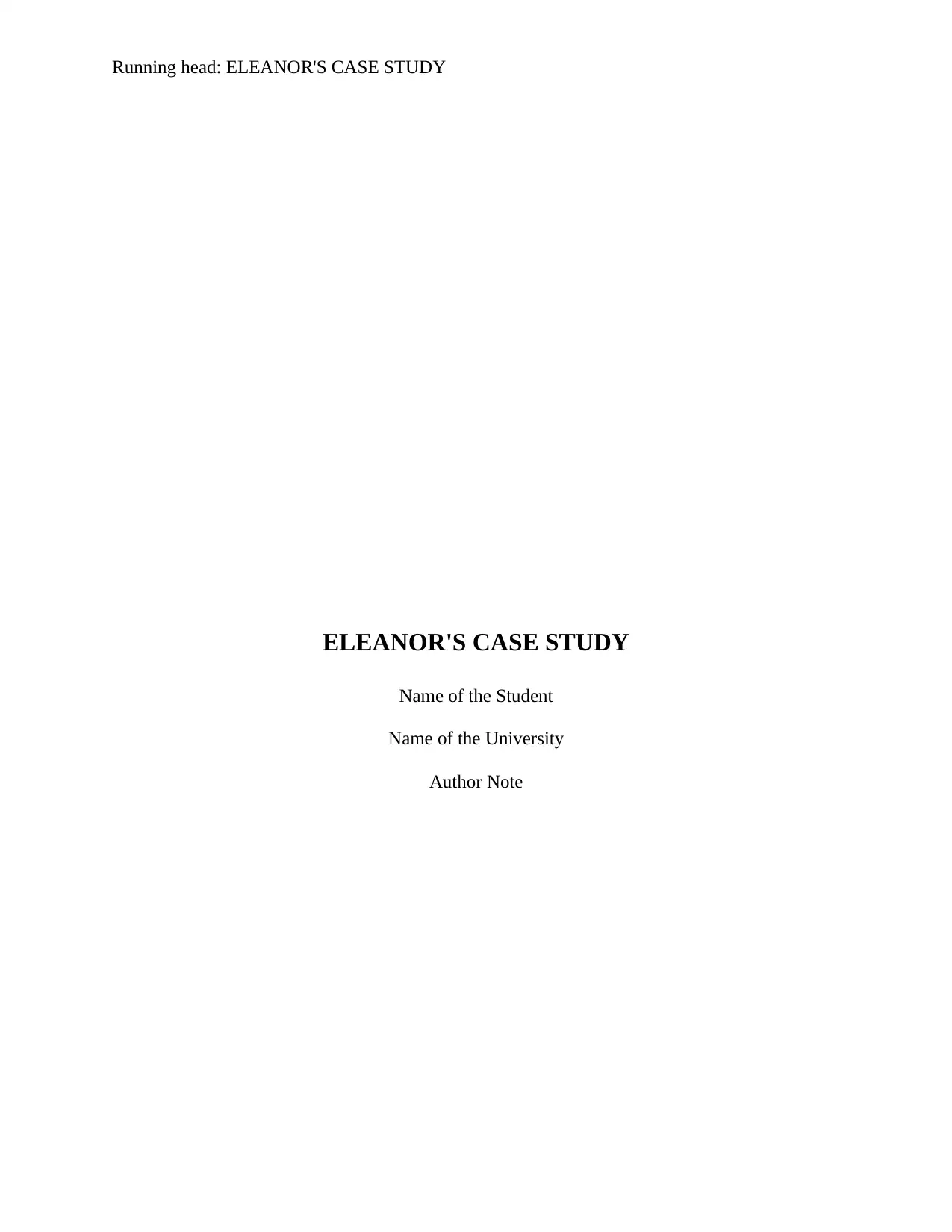
Running head: ELEANOR'S CASE STUDY
ELEANOR'S CASE STUDY
Name of the Student
Name of the University
Author Note
ELEANOR'S CASE STUDY
Name of the Student
Name of the University
Author Note
Secure Best Marks with AI Grader
Need help grading? Try our AI Grader for instant feedback on your assignments.
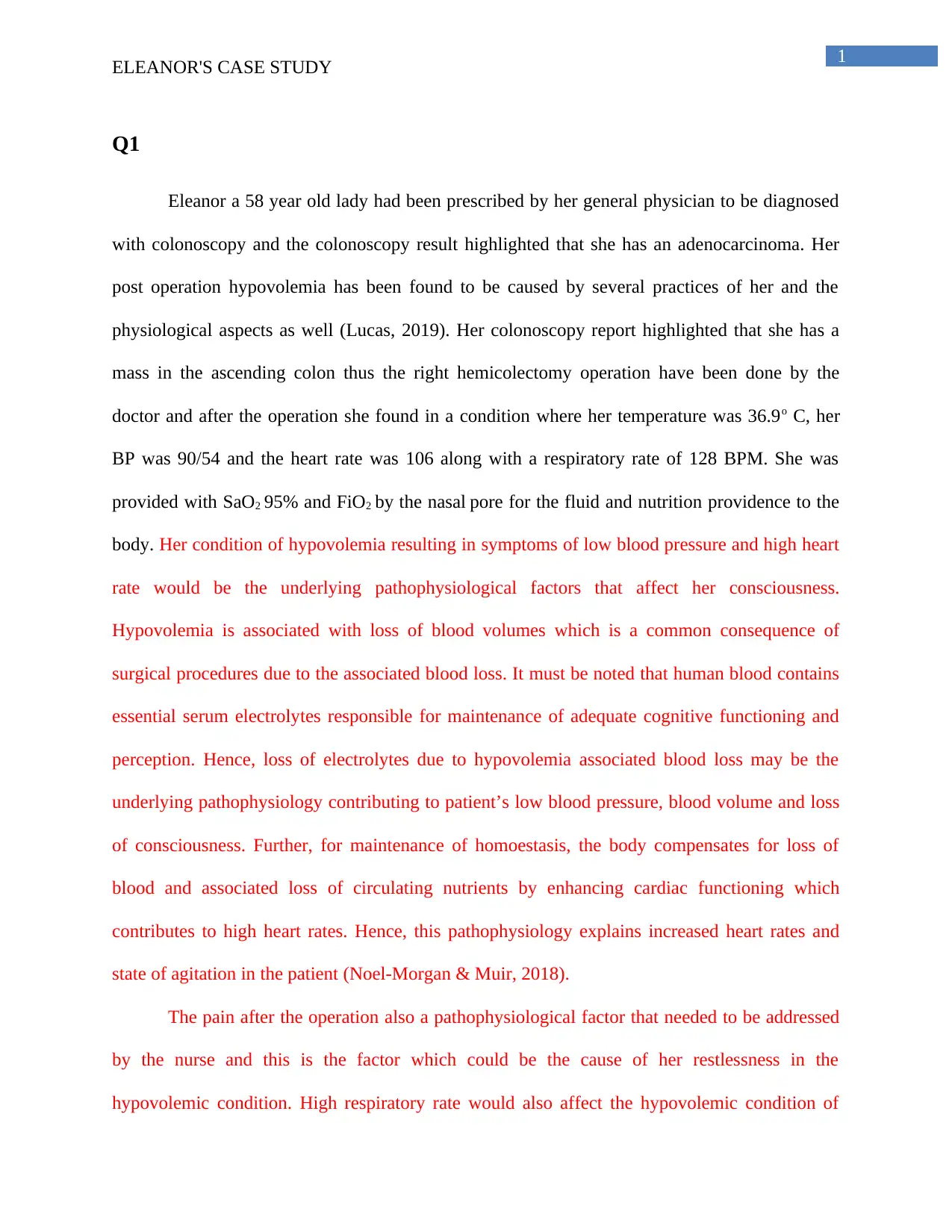
1
ELEANOR'S CASE STUDY
Q1
Eleanor a 58 year old lady had been prescribed by her general physician to be diagnosed
with colonoscopy and the colonoscopy result highlighted that she has an adenocarcinoma. Her
post operation hypovolemia has been found to be caused by several practices of her and the
physiological aspects as well (Lucas, 2019). Her colonoscopy report highlighted that she has a
mass in the ascending colon thus the right hemicolectomy operation have been done by the
doctor and after the operation she found in a condition where her temperature was 36.9o C, her
BP was 90/54 and the heart rate was 106 along with a respiratory rate of 128 BPM. She was
provided with SaO2 95% and FiO2 by the nasal pore for the fluid and nutrition providence to the
body. Her condition of hypovolemia resulting in symptoms of low blood pressure and high heart
rate would be the underlying pathophysiological factors that affect her consciousness.
Hypovolemia is associated with loss of blood volumes which is a common consequence of
surgical procedures due to the associated blood loss. It must be noted that human blood contains
essential serum electrolytes responsible for maintenance of adequate cognitive functioning and
perception. Hence, loss of electrolytes due to hypovolemia associated blood loss may be the
underlying pathophysiology contributing to patient’s low blood pressure, blood volume and loss
of consciousness. Further, for maintenance of homoestasis, the body compensates for loss of
blood and associated loss of circulating nutrients by enhancing cardiac functioning which
contributes to high heart rates. Hence, this pathophysiology explains increased heart rates and
state of agitation in the patient (Noel-Morgan & Muir, 2018).
The pain after the operation also a pathophysiological factor that needed to be addressed
by the nurse and this is the factor which could be the cause of her restlessness in the
hypovolemic condition. High respiratory rate would also affect the hypovolemic condition of
ELEANOR'S CASE STUDY
Q1
Eleanor a 58 year old lady had been prescribed by her general physician to be diagnosed
with colonoscopy and the colonoscopy result highlighted that she has an adenocarcinoma. Her
post operation hypovolemia has been found to be caused by several practices of her and the
physiological aspects as well (Lucas, 2019). Her colonoscopy report highlighted that she has a
mass in the ascending colon thus the right hemicolectomy operation have been done by the
doctor and after the operation she found in a condition where her temperature was 36.9o C, her
BP was 90/54 and the heart rate was 106 along with a respiratory rate of 128 BPM. She was
provided with SaO2 95% and FiO2 by the nasal pore for the fluid and nutrition providence to the
body. Her condition of hypovolemia resulting in symptoms of low blood pressure and high heart
rate would be the underlying pathophysiological factors that affect her consciousness.
Hypovolemia is associated with loss of blood volumes which is a common consequence of
surgical procedures due to the associated blood loss. It must be noted that human blood contains
essential serum electrolytes responsible for maintenance of adequate cognitive functioning and
perception. Hence, loss of electrolytes due to hypovolemia associated blood loss may be the
underlying pathophysiology contributing to patient’s low blood pressure, blood volume and loss
of consciousness. Further, for maintenance of homoestasis, the body compensates for loss of
blood and associated loss of circulating nutrients by enhancing cardiac functioning which
contributes to high heart rates. Hence, this pathophysiology explains increased heart rates and
state of agitation in the patient (Noel-Morgan & Muir, 2018).
The pain after the operation also a pathophysiological factor that needed to be addressed
by the nurse and this is the factor which could be the cause of her restlessness in the
hypovolemic condition. High respiratory rate would also affect the hypovolemic condition of
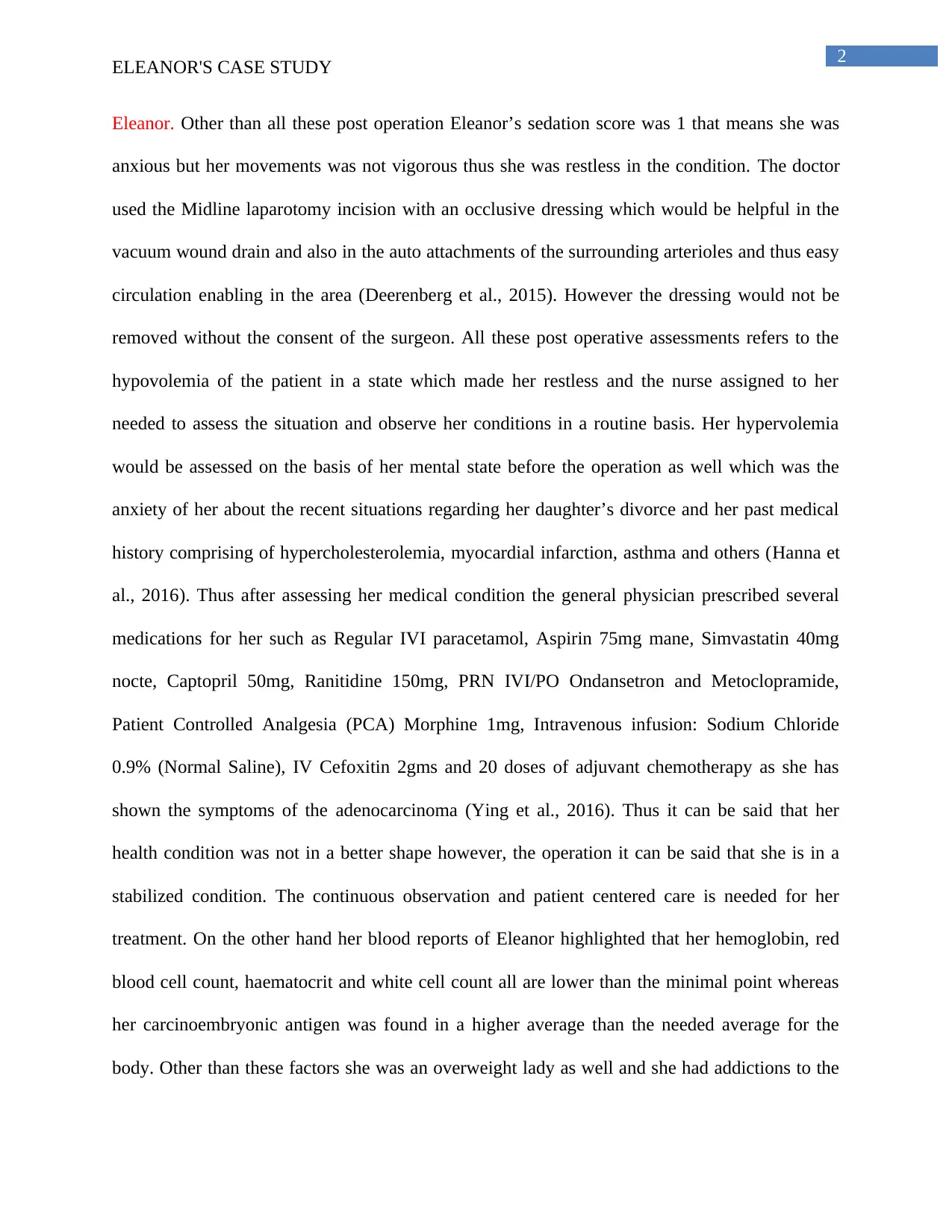
2
ELEANOR'S CASE STUDY
Eleanor. Other than all these post operation Eleanor’s sedation score was 1 that means she was
anxious but her movements was not vigorous thus she was restless in the condition. The doctor
used the Midline laparotomy incision with an occlusive dressing which would be helpful in the
vacuum wound drain and also in the auto attachments of the surrounding arterioles and thus easy
circulation enabling in the area (Deerenberg et al., 2015). However the dressing would not be
removed without the consent of the surgeon. All these post operative assessments refers to the
hypovolemia of the patient in a state which made her restless and the nurse assigned to her
needed to assess the situation and observe her conditions in a routine basis. Her hypervolemia
would be assessed on the basis of her mental state before the operation as well which was the
anxiety of her about the recent situations regarding her daughter’s divorce and her past medical
history comprising of hypercholesterolemia, myocardial infarction, asthma and others (Hanna et
al., 2016). Thus after assessing her medical condition the general physician prescribed several
medications for her such as Regular IVI paracetamol, Aspirin 75mg mane, Simvastatin 40mg
nocte, Captopril 50mg, Ranitidine 150mg, PRN IVI/PO Ondansetron and Metoclopramide,
Patient Controlled Analgesia (PCA) Morphine 1mg, Intravenous infusion: Sodium Chloride
0.9% (Normal Saline), IV Cefoxitin 2gms and 20 doses of adjuvant chemotherapy as she has
shown the symptoms of the adenocarcinoma (Ying et al., 2016). Thus it can be said that her
health condition was not in a better shape however, the operation it can be said that she is in a
stabilized condition. The continuous observation and patient centered care is needed for her
treatment. On the other hand her blood reports of Eleanor highlighted that her hemoglobin, red
blood cell count, haematocrit and white cell count all are lower than the minimal point whereas
her carcinoembryonic antigen was found in a higher average than the needed average for the
body. Other than these factors she was an overweight lady as well and she had addictions to the
ELEANOR'S CASE STUDY
Eleanor. Other than all these post operation Eleanor’s sedation score was 1 that means she was
anxious but her movements was not vigorous thus she was restless in the condition. The doctor
used the Midline laparotomy incision with an occlusive dressing which would be helpful in the
vacuum wound drain and also in the auto attachments of the surrounding arterioles and thus easy
circulation enabling in the area (Deerenberg et al., 2015). However the dressing would not be
removed without the consent of the surgeon. All these post operative assessments refers to the
hypovolemia of the patient in a state which made her restless and the nurse assigned to her
needed to assess the situation and observe her conditions in a routine basis. Her hypervolemia
would be assessed on the basis of her mental state before the operation as well which was the
anxiety of her about the recent situations regarding her daughter’s divorce and her past medical
history comprising of hypercholesterolemia, myocardial infarction, asthma and others (Hanna et
al., 2016). Thus after assessing her medical condition the general physician prescribed several
medications for her such as Regular IVI paracetamol, Aspirin 75mg mane, Simvastatin 40mg
nocte, Captopril 50mg, Ranitidine 150mg, PRN IVI/PO Ondansetron and Metoclopramide,
Patient Controlled Analgesia (PCA) Morphine 1mg, Intravenous infusion: Sodium Chloride
0.9% (Normal Saline), IV Cefoxitin 2gms and 20 doses of adjuvant chemotherapy as she has
shown the symptoms of the adenocarcinoma (Ying et al., 2016). Thus it can be said that her
health condition was not in a better shape however, the operation it can be said that she is in a
stabilized condition. The continuous observation and patient centered care is needed for her
treatment. On the other hand her blood reports of Eleanor highlighted that her hemoglobin, red
blood cell count, haematocrit and white cell count all are lower than the minimal point whereas
her carcinoembryonic antigen was found in a higher average than the needed average for the
body. Other than these factors she was an overweight lady as well and she had addictions to the
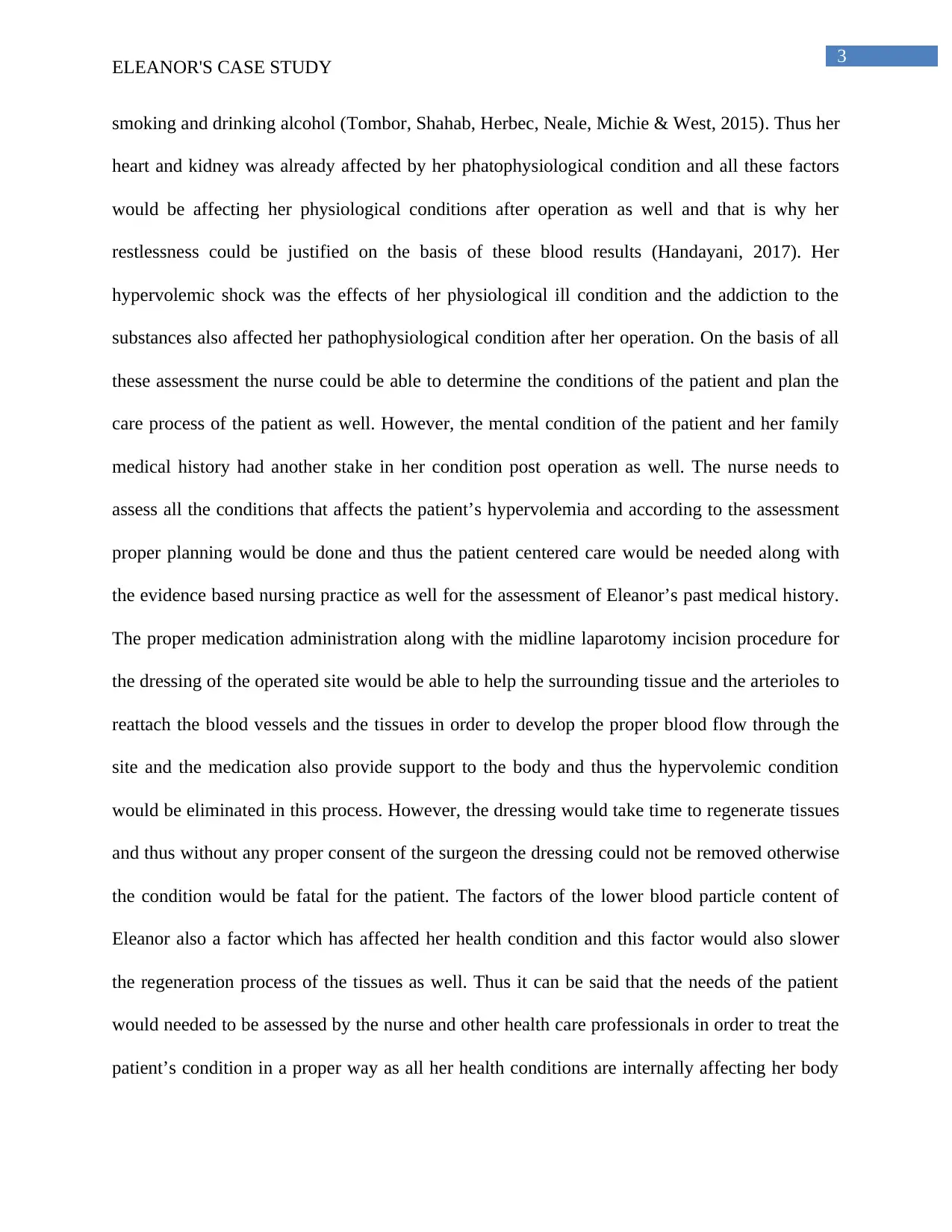
3
ELEANOR'S CASE STUDY
smoking and drinking alcohol (Tombor, Shahab, Herbec, Neale, Michie & West, 2015). Thus her
heart and kidney was already affected by her phatophysiological condition and all these factors
would be affecting her physiological conditions after operation as well and that is why her
restlessness could be justified on the basis of these blood results (Handayani, 2017). Her
hypervolemic shock was the effects of her physiological ill condition and the addiction to the
substances also affected her pathophysiological condition after her operation. On the basis of all
these assessment the nurse could be able to determine the conditions of the patient and plan the
care process of the patient as well. However, the mental condition of the patient and her family
medical history had another stake in her condition post operation as well. The nurse needs to
assess all the conditions that affects the patient’s hypervolemia and according to the assessment
proper planning would be done and thus the patient centered care would be needed along with
the evidence based nursing practice as well for the assessment of Eleanor’s past medical history.
The proper medication administration along with the midline laparotomy incision procedure for
the dressing of the operated site would be able to help the surrounding tissue and the arterioles to
reattach the blood vessels and the tissues in order to develop the proper blood flow through the
site and the medication also provide support to the body and thus the hypervolemic condition
would be eliminated in this process. However, the dressing would take time to regenerate tissues
and thus without any proper consent of the surgeon the dressing could not be removed otherwise
the condition would be fatal for the patient. The factors of the lower blood particle content of
Eleanor also a factor which has affected her health condition and this factor would also slower
the regeneration process of the tissues as well. Thus it can be said that the needs of the patient
would needed to be assessed by the nurse and other health care professionals in order to treat the
patient’s condition in a proper way as all her health conditions are internally affecting her body
ELEANOR'S CASE STUDY
smoking and drinking alcohol (Tombor, Shahab, Herbec, Neale, Michie & West, 2015). Thus her
heart and kidney was already affected by her phatophysiological condition and all these factors
would be affecting her physiological conditions after operation as well and that is why her
restlessness could be justified on the basis of these blood results (Handayani, 2017). Her
hypervolemic shock was the effects of her physiological ill condition and the addiction to the
substances also affected her pathophysiological condition after her operation. On the basis of all
these assessment the nurse could be able to determine the conditions of the patient and plan the
care process of the patient as well. However, the mental condition of the patient and her family
medical history had another stake in her condition post operation as well. The nurse needs to
assess all the conditions that affects the patient’s hypervolemia and according to the assessment
proper planning would be done and thus the patient centered care would be needed along with
the evidence based nursing practice as well for the assessment of Eleanor’s past medical history.
The proper medication administration along with the midline laparotomy incision procedure for
the dressing of the operated site would be able to help the surrounding tissue and the arterioles to
reattach the blood vessels and the tissues in order to develop the proper blood flow through the
site and the medication also provide support to the body and thus the hypervolemic condition
would be eliminated in this process. However, the dressing would take time to regenerate tissues
and thus without any proper consent of the surgeon the dressing could not be removed otherwise
the condition would be fatal for the patient. The factors of the lower blood particle content of
Eleanor also a factor which has affected her health condition and this factor would also slower
the regeneration process of the tissues as well. Thus it can be said that the needs of the patient
would needed to be assessed by the nurse and other health care professionals in order to treat the
patient’s condition in a proper way as all her health conditions are internally affecting her body
Secure Best Marks with AI Grader
Need help grading? Try our AI Grader for instant feedback on your assignments.

4
ELEANOR'S CASE STUDY
the patient would not have the proper knowledge of these conditions as well (Mirica et al., 2016).
The information gathered from the lab report that highlights her cancerous conditions also
needed to be considered as a pathophysiological condition as it affects the physiology of the
human body in different ways such as tissue damage, cardiovascular damage, metabolic damage
and others. Thus the post operative hypovolemia and the cancerous condition of the patient is the
primary pathophysiological aspects along with the pain assessment, renal function and proper
medication for the patient.
Q2
According to data collected about Eleanor it can be said that there are several problems
which leads to her ill health condition. The prioritizing factors for the health care professionals
about Eleanor’s health was the recent anxieties of her, addictive and lifestyle without any
discipline, her pathophysiological lab reports that are the blood reports and the obese condition
of her; all these factors lead to her post operation hypervolemia and also the biopsy report
highlighted that she has adenocarcinoma that can be termed as cancer. These problems were
determined by the lab reports of the patient. The blood reports of the patient clearly highlighted
that her haemoglobin rate, red blood cell rate, haematocrite rate, white blood cell rate lower than
the actual rate needed to have by a person thus her physiological immunity and the fluid ratio of
her body was in the jeopardy and affected her body in a manner that leads to the cancerous
condition. On the other hand her addiction towards smoking and alcohol also affects her heart,
liver and the kidney thus the purification process of blood and other body fluid could not be done
in a proper way thus the colon cancer resulted in her body. She has experienced recent anxieties
also and anxiety has a greater effect on the mental state of the body. These effects also affect the
hormonal and the enzymatic actions of the body thus it affects the metabolic and other systems
ELEANOR'S CASE STUDY
the patient would not have the proper knowledge of these conditions as well (Mirica et al., 2016).
The information gathered from the lab report that highlights her cancerous conditions also
needed to be considered as a pathophysiological condition as it affects the physiology of the
human body in different ways such as tissue damage, cardiovascular damage, metabolic damage
and others. Thus the post operative hypovolemia and the cancerous condition of the patient is the
primary pathophysiological aspects along with the pain assessment, renal function and proper
medication for the patient.
Q2
According to data collected about Eleanor it can be said that there are several problems
which leads to her ill health condition. The prioritizing factors for the health care professionals
about Eleanor’s health was the recent anxieties of her, addictive and lifestyle without any
discipline, her pathophysiological lab reports that are the blood reports and the obese condition
of her; all these factors lead to her post operation hypervolemia and also the biopsy report
highlighted that she has adenocarcinoma that can be termed as cancer. These problems were
determined by the lab reports of the patient. The blood reports of the patient clearly highlighted
that her haemoglobin rate, red blood cell rate, haematocrite rate, white blood cell rate lower than
the actual rate needed to have by a person thus her physiological immunity and the fluid ratio of
her body was in the jeopardy and affected her body in a manner that leads to the cancerous
condition. On the other hand her addiction towards smoking and alcohol also affects her heart,
liver and the kidney thus the purification process of blood and other body fluid could not be done
in a proper way thus the colon cancer resulted in her body. She has experienced recent anxieties
also and anxiety has a greater effect on the mental state of the body. These effects also affect the
hormonal and the enzymatic actions of the body thus it affects the metabolic and other systems
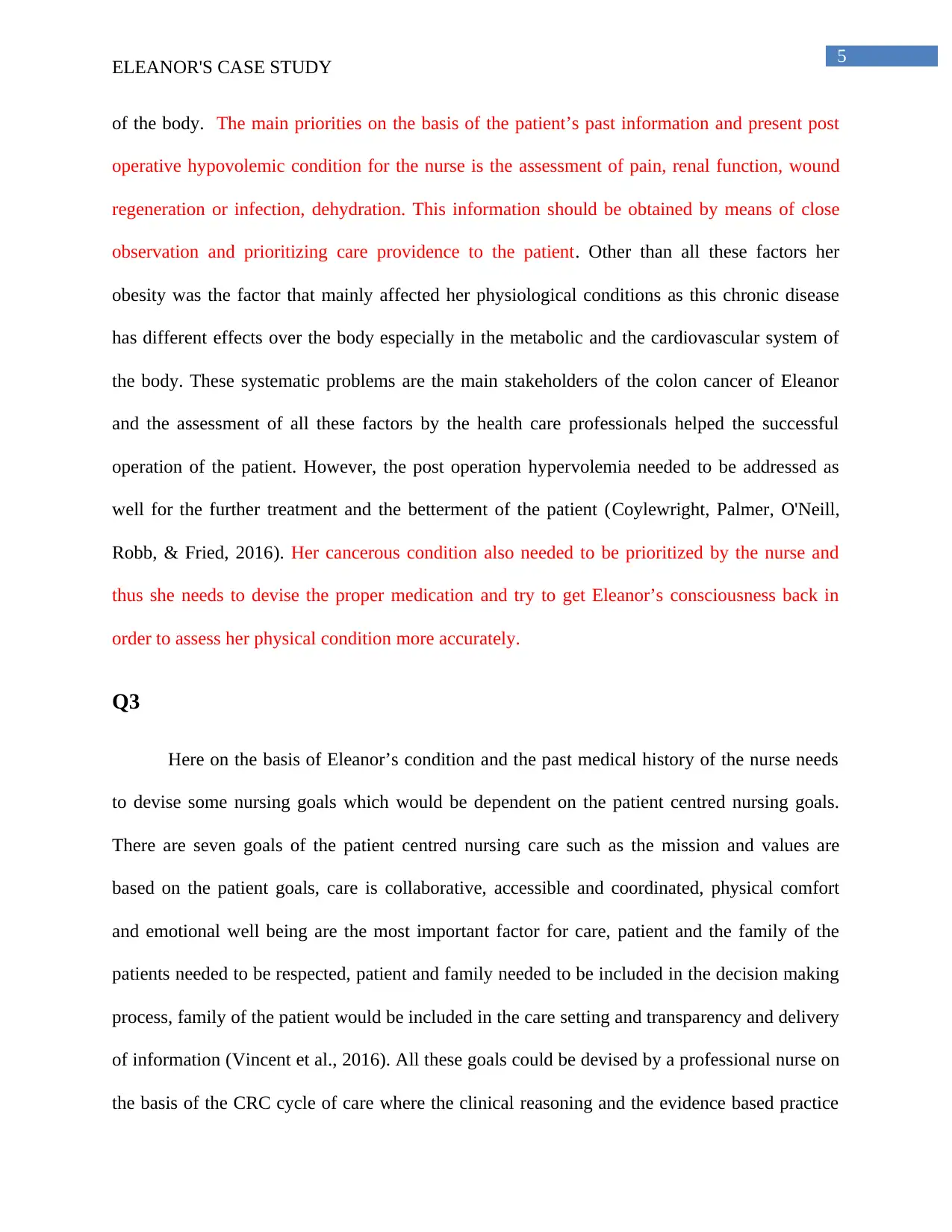
5
ELEANOR'S CASE STUDY
of the body. The main priorities on the basis of the patient’s past information and present post
operative hypovolemic condition for the nurse is the assessment of pain, renal function, wound
regeneration or infection, dehydration. This information should be obtained by means of close
observation and prioritizing care providence to the patient. Other than all these factors her
obesity was the factor that mainly affected her physiological conditions as this chronic disease
has different effects over the body especially in the metabolic and the cardiovascular system of
the body. These systematic problems are the main stakeholders of the colon cancer of Eleanor
and the assessment of all these factors by the health care professionals helped the successful
operation of the patient. However, the post operation hypervolemia needed to be addressed as
well for the further treatment and the betterment of the patient (Coylewright, Palmer, O'Neill,
Robb, & Fried, 2016). Her cancerous condition also needed to be prioritized by the nurse and
thus she needs to devise the proper medication and try to get Eleanor’s consciousness back in
order to assess her physical condition more accurately.
Q3
Here on the basis of Eleanor’s condition and the past medical history of the nurse needs
to devise some nursing goals which would be dependent on the patient centred nursing goals.
There are seven goals of the patient centred nursing care such as the mission and values are
based on the patient goals, care is collaborative, accessible and coordinated, physical comfort
and emotional well being are the most important factor for care, patient and the family of the
patients needed to be respected, patient and family needed to be included in the decision making
process, family of the patient would be included in the care setting and transparency and delivery
of information (Vincent et al., 2016). All these goals could be devised by a professional nurse on
the basis of the CRC cycle of care where the clinical reasoning and the evidence based practice
ELEANOR'S CASE STUDY
of the body. The main priorities on the basis of the patient’s past information and present post
operative hypovolemic condition for the nurse is the assessment of pain, renal function, wound
regeneration or infection, dehydration. This information should be obtained by means of close
observation and prioritizing care providence to the patient. Other than all these factors her
obesity was the factor that mainly affected her physiological conditions as this chronic disease
has different effects over the body especially in the metabolic and the cardiovascular system of
the body. These systematic problems are the main stakeholders of the colon cancer of Eleanor
and the assessment of all these factors by the health care professionals helped the successful
operation of the patient. However, the post operation hypervolemia needed to be addressed as
well for the further treatment and the betterment of the patient (Coylewright, Palmer, O'Neill,
Robb, & Fried, 2016). Her cancerous condition also needed to be prioritized by the nurse and
thus she needs to devise the proper medication and try to get Eleanor’s consciousness back in
order to assess her physical condition more accurately.
Q3
Here on the basis of Eleanor’s condition and the past medical history of the nurse needs
to devise some nursing goals which would be dependent on the patient centred nursing goals.
There are seven goals of the patient centred nursing care such as the mission and values are
based on the patient goals, care is collaborative, accessible and coordinated, physical comfort
and emotional well being are the most important factor for care, patient and the family of the
patients needed to be respected, patient and family needed to be included in the decision making
process, family of the patient would be included in the care setting and transparency and delivery
of information (Vincent et al., 2016). All these goals could be devised by a professional nurse on
the basis of the CRC cycle of care where the clinical reasoning and the evidence based practice
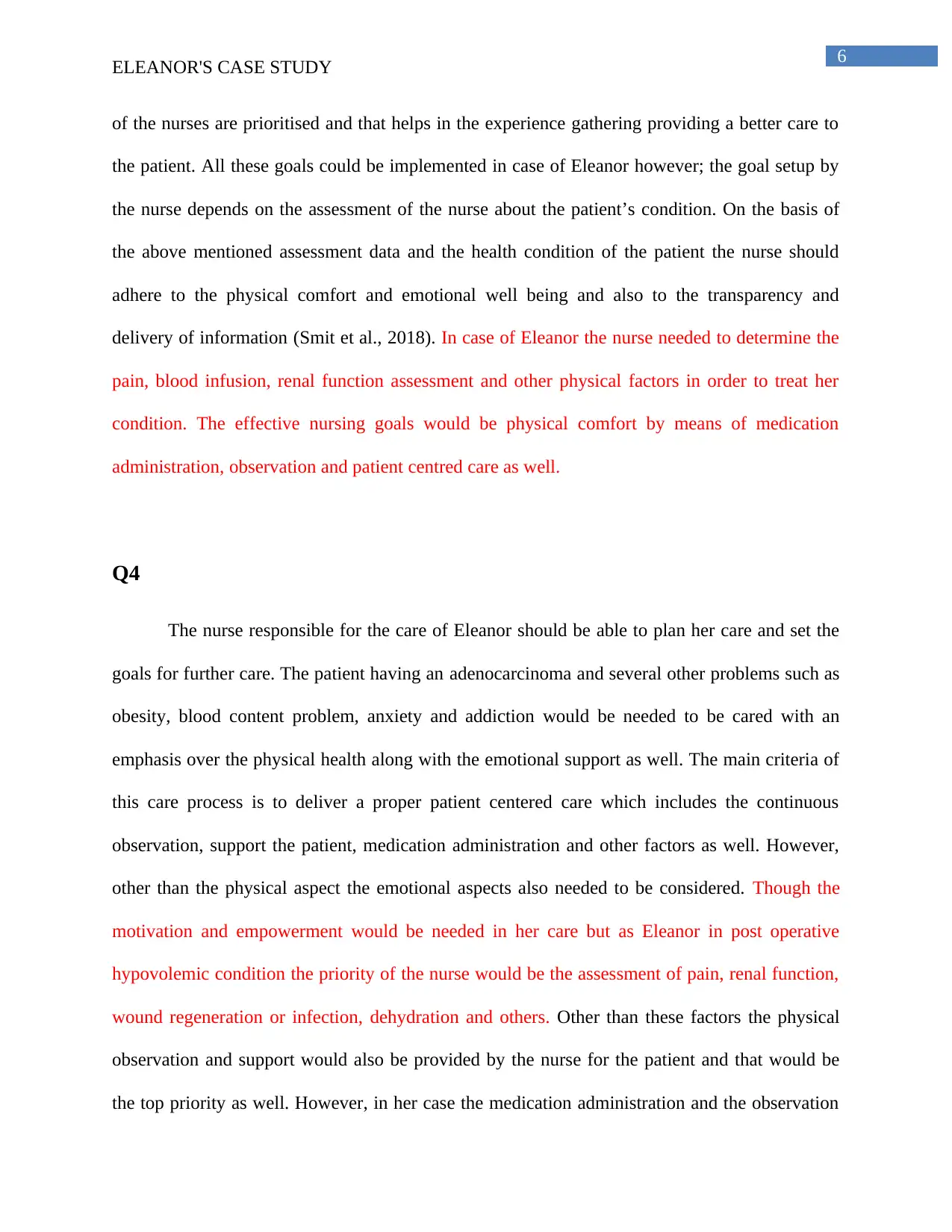
6
ELEANOR'S CASE STUDY
of the nurses are prioritised and that helps in the experience gathering providing a better care to
the patient. All these goals could be implemented in case of Eleanor however; the goal setup by
the nurse depends on the assessment of the nurse about the patient’s condition. On the basis of
the above mentioned assessment data and the health condition of the patient the nurse should
adhere to the physical comfort and emotional well being and also to the transparency and
delivery of information (Smit et al., 2018). In case of Eleanor the nurse needed to determine the
pain, blood infusion, renal function assessment and other physical factors in order to treat her
condition. The effective nursing goals would be physical comfort by means of medication
administration, observation and patient centred care as well.
Q4
The nurse responsible for the care of Eleanor should be able to plan her care and set the
goals for further care. The patient having an adenocarcinoma and several other problems such as
obesity, blood content problem, anxiety and addiction would be needed to be cared with an
emphasis over the physical health along with the emotional support as well. The main criteria of
this care process is to deliver a proper patient centered care which includes the continuous
observation, support the patient, medication administration and other factors as well. However,
other than the physical aspect the emotional aspects also needed to be considered. Though the
motivation and empowerment would be needed in her care but as Eleanor in post operative
hypovolemic condition the priority of the nurse would be the assessment of pain, renal function,
wound regeneration or infection, dehydration and others. Other than these factors the physical
observation and support would also be provided by the nurse for the patient and that would be
the top priority as well. However, in her case the medication administration and the observation
ELEANOR'S CASE STUDY
of the nurses are prioritised and that helps in the experience gathering providing a better care to
the patient. All these goals could be implemented in case of Eleanor however; the goal setup by
the nurse depends on the assessment of the nurse about the patient’s condition. On the basis of
the above mentioned assessment data and the health condition of the patient the nurse should
adhere to the physical comfort and emotional well being and also to the transparency and
delivery of information (Smit et al., 2018). In case of Eleanor the nurse needed to determine the
pain, blood infusion, renal function assessment and other physical factors in order to treat her
condition. The effective nursing goals would be physical comfort by means of medication
administration, observation and patient centred care as well.
Q4
The nurse responsible for the care of Eleanor should be able to plan her care and set the
goals for further care. The patient having an adenocarcinoma and several other problems such as
obesity, blood content problem, anxiety and addiction would be needed to be cared with an
emphasis over the physical health along with the emotional support as well. The main criteria of
this care process is to deliver a proper patient centered care which includes the continuous
observation, support the patient, medication administration and other factors as well. However,
other than the physical aspect the emotional aspects also needed to be considered. Though the
motivation and empowerment would be needed in her care but as Eleanor in post operative
hypovolemic condition the priority of the nurse would be the assessment of pain, renal function,
wound regeneration or infection, dehydration and others. Other than these factors the physical
observation and support would also be provided by the nurse for the patient and that would be
the top priority as well. However, in her case the medication administration and the observation
Paraphrase This Document
Need a fresh take? Get an instant paraphrase of this document with our AI Paraphraser
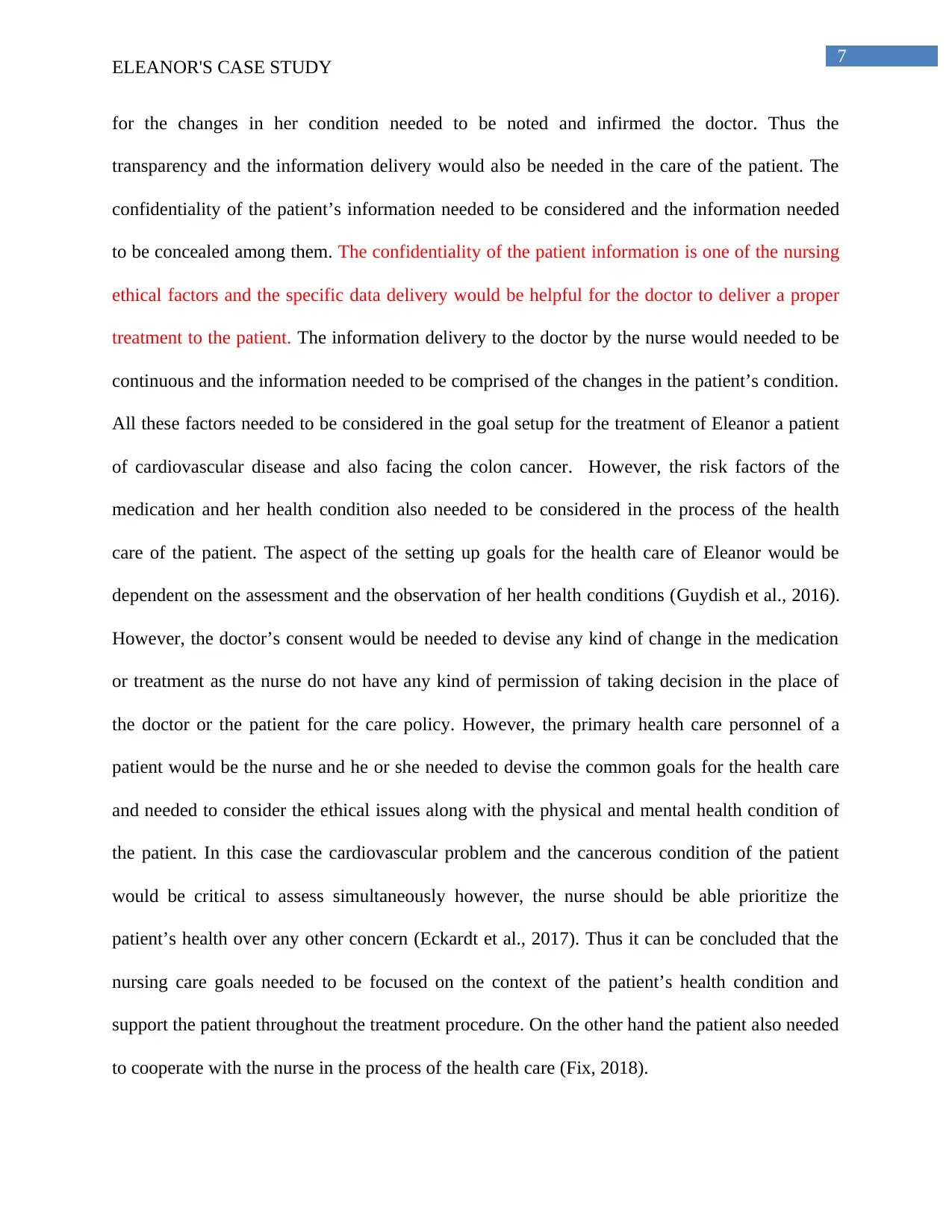
7
ELEANOR'S CASE STUDY
for the changes in her condition needed to be noted and infirmed the doctor. Thus the
transparency and the information delivery would also be needed in the care of the patient. The
confidentiality of the patient’s information needed to be considered and the information needed
to be concealed among them. The confidentiality of the patient information is one of the nursing
ethical factors and the specific data delivery would be helpful for the doctor to deliver a proper
treatment to the patient. The information delivery to the doctor by the nurse would needed to be
continuous and the information needed to be comprised of the changes in the patient’s condition.
All these factors needed to be considered in the goal setup for the treatment of Eleanor a patient
of cardiovascular disease and also facing the colon cancer. However, the risk factors of the
medication and her health condition also needed to be considered in the process of the health
care of the patient. The aspect of the setting up goals for the health care of Eleanor would be
dependent on the assessment and the observation of her health conditions (Guydish et al., 2016).
However, the doctor’s consent would be needed to devise any kind of change in the medication
or treatment as the nurse do not have any kind of permission of taking decision in the place of
the doctor or the patient for the care policy. However, the primary health care personnel of a
patient would be the nurse and he or she needed to devise the common goals for the health care
and needed to consider the ethical issues along with the physical and mental health condition of
the patient. In this case the cardiovascular problem and the cancerous condition of the patient
would be critical to assess simultaneously however, the nurse should be able prioritize the
patient’s health over any other concern (Eckardt et al., 2017). Thus it can be concluded that the
nursing care goals needed to be focused on the context of the patient’s health condition and
support the patient throughout the treatment procedure. On the other hand the patient also needed
to cooperate with the nurse in the process of the health care (Fix, 2018).
ELEANOR'S CASE STUDY
for the changes in her condition needed to be noted and infirmed the doctor. Thus the
transparency and the information delivery would also be needed in the care of the patient. The
confidentiality of the patient’s information needed to be considered and the information needed
to be concealed among them. The confidentiality of the patient information is one of the nursing
ethical factors and the specific data delivery would be helpful for the doctor to deliver a proper
treatment to the patient. The information delivery to the doctor by the nurse would needed to be
continuous and the information needed to be comprised of the changes in the patient’s condition.
All these factors needed to be considered in the goal setup for the treatment of Eleanor a patient
of cardiovascular disease and also facing the colon cancer. However, the risk factors of the
medication and her health condition also needed to be considered in the process of the health
care of the patient. The aspect of the setting up goals for the health care of Eleanor would be
dependent on the assessment and the observation of her health conditions (Guydish et al., 2016).
However, the doctor’s consent would be needed to devise any kind of change in the medication
or treatment as the nurse do not have any kind of permission of taking decision in the place of
the doctor or the patient for the care policy. However, the primary health care personnel of a
patient would be the nurse and he or she needed to devise the common goals for the health care
and needed to consider the ethical issues along with the physical and mental health condition of
the patient. In this case the cardiovascular problem and the cancerous condition of the patient
would be critical to assess simultaneously however, the nurse should be able prioritize the
patient’s health over any other concern (Eckardt et al., 2017). Thus it can be concluded that the
nursing care goals needed to be focused on the context of the patient’s health condition and
support the patient throughout the treatment procedure. On the other hand the patient also needed
to cooperate with the nurse in the process of the health care (Fix, 2018).
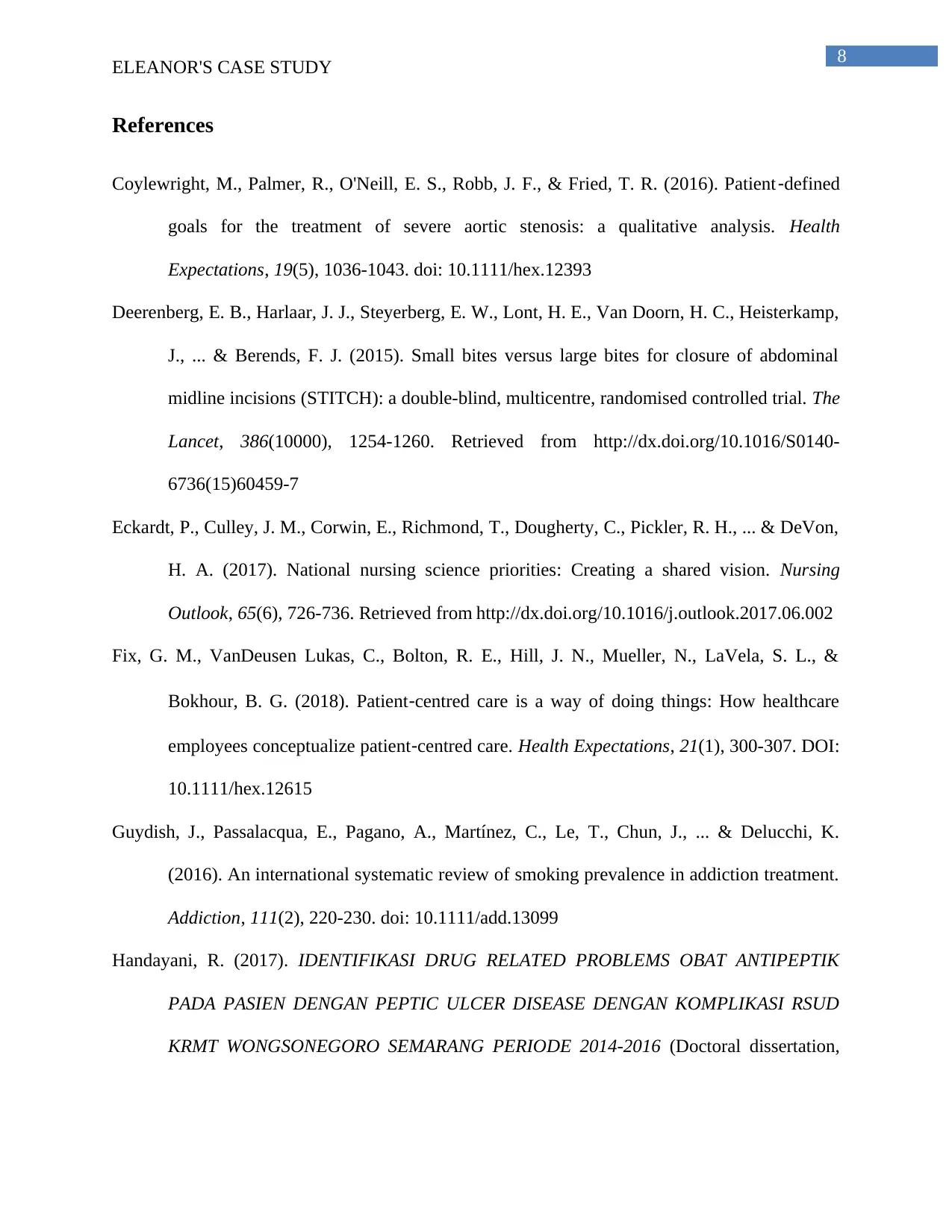
8
ELEANOR'S CASE STUDY
References
Coylewright, M., Palmer, R., O'Neill, E. S., Robb, J. F., & Fried, T. R. (2016). Patient‐defined
goals for the treatment of severe aortic stenosis: a qualitative analysis. Health
Expectations, 19(5), 1036-1043. doi: 10.1111/hex.12393
Deerenberg, E. B., Harlaar, J. J., Steyerberg, E. W., Lont, H. E., Van Doorn, H. C., Heisterkamp,
J., ... & Berends, F. J. (2015). Small bites versus large bites for closure of abdominal
midline incisions (STITCH): a double-blind, multicentre, randomised controlled trial. The
Lancet, 386(10000), 1254-1260. Retrieved from http://dx.doi.org/10.1016/S0140-
6736(15)60459-7
Eckardt, P., Culley, J. M., Corwin, E., Richmond, T., Dougherty, C., Pickler, R. H., ... & DeVon,
H. A. (2017). National nursing science priorities: Creating a shared vision. Nursing
Outlook, 65(6), 726-736. Retrieved from http://dx.doi.org/10.1016/j.outlook.2017.06.002
Fix, G. M., VanDeusen Lukas, C., Bolton, R. E., Hill, J. N., Mueller, N., LaVela, S. L., &
Bokhour, B. G. (2018). Patient‐centred care is a way of doing things: How healthcare
employees conceptualize patient‐centred care. Health Expectations, 21(1), 300-307. DOI:
10.1111/hex.12615
Guydish, J., Passalacqua, E., Pagano, A., Martínez, C., Le, T., Chun, J., ... & Delucchi, K.
(2016). An international systematic review of smoking prevalence in addiction treatment.
Addiction, 111(2), 220-230. doi: 10.1111/add.13099
Handayani, R. (2017). IDENTIFIKASI DRUG RELATED PROBLEMS OBAT ANTIPEPTIK
PADA PASIEN DENGAN PEPTIC ULCER DISEASE DENGAN KOMPLIKASI RSUD
KRMT WONGSONEGORO SEMARANG PERIODE 2014-2016 (Doctoral dissertation,
ELEANOR'S CASE STUDY
References
Coylewright, M., Palmer, R., O'Neill, E. S., Robb, J. F., & Fried, T. R. (2016). Patient‐defined
goals for the treatment of severe aortic stenosis: a qualitative analysis. Health
Expectations, 19(5), 1036-1043. doi: 10.1111/hex.12393
Deerenberg, E. B., Harlaar, J. J., Steyerberg, E. W., Lont, H. E., Van Doorn, H. C., Heisterkamp,
J., ... & Berends, F. J. (2015). Small bites versus large bites for closure of abdominal
midline incisions (STITCH): a double-blind, multicentre, randomised controlled trial. The
Lancet, 386(10000), 1254-1260. Retrieved from http://dx.doi.org/10.1016/S0140-
6736(15)60459-7
Eckardt, P., Culley, J. M., Corwin, E., Richmond, T., Dougherty, C., Pickler, R. H., ... & DeVon,
H. A. (2017). National nursing science priorities: Creating a shared vision. Nursing
Outlook, 65(6), 726-736. Retrieved from http://dx.doi.org/10.1016/j.outlook.2017.06.002
Fix, G. M., VanDeusen Lukas, C., Bolton, R. E., Hill, J. N., Mueller, N., LaVela, S. L., &
Bokhour, B. G. (2018). Patient‐centred care is a way of doing things: How healthcare
employees conceptualize patient‐centred care. Health Expectations, 21(1), 300-307. DOI:
10.1111/hex.12615
Guydish, J., Passalacqua, E., Pagano, A., Martínez, C., Le, T., Chun, J., ... & Delucchi, K.
(2016). An international systematic review of smoking prevalence in addiction treatment.
Addiction, 111(2), 220-230. doi: 10.1111/add.13099
Handayani, R. (2017). IDENTIFIKASI DRUG RELATED PROBLEMS OBAT ANTIPEPTIK
PADA PASIEN DENGAN PEPTIC ULCER DISEASE DENGAN KOMPLIKASI RSUD
KRMT WONGSONEGORO SEMARANG PERIODE 2014-2016 (Doctoral dissertation,
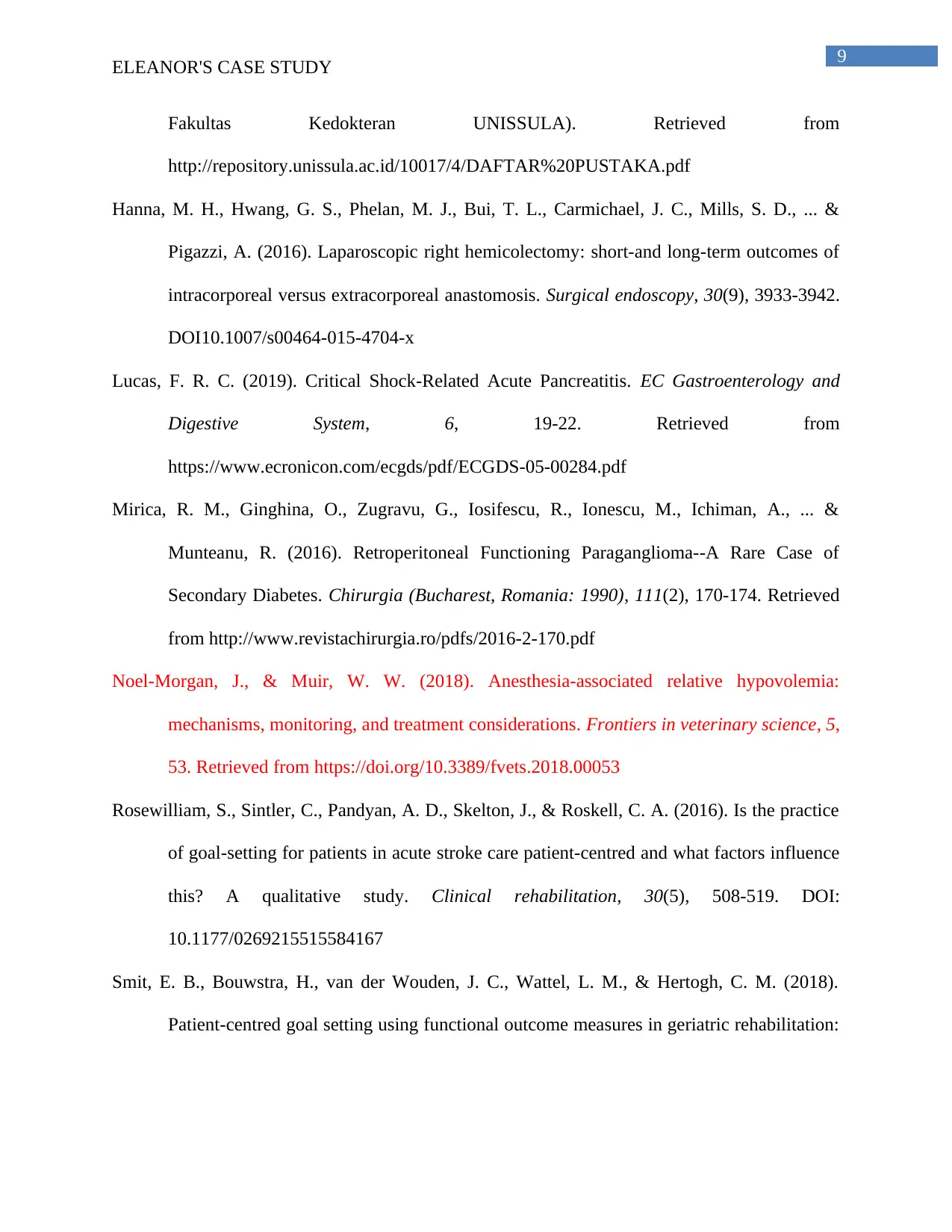
9
ELEANOR'S CASE STUDY
Fakultas Kedokteran UNISSULA). Retrieved from
http://repository.unissula.ac.id/10017/4/DAFTAR%20PUSTAKA.pdf
Hanna, M. H., Hwang, G. S., Phelan, M. J., Bui, T. L., Carmichael, J. C., Mills, S. D., ... &
Pigazzi, A. (2016). Laparoscopic right hemicolectomy: short-and long-term outcomes of
intracorporeal versus extracorporeal anastomosis. Surgical endoscopy, 30(9), 3933-3942.
DOI10.1007/s00464-015-4704-x
Lucas, F. R. C. (2019). Critical Shock-Related Acute Pancreatitis. EC Gastroenterology and
Digestive System, 6, 19-22. Retrieved from
https://www.ecronicon.com/ecgds/pdf/ECGDS-05-00284.pdf
Mirica, R. M., Ginghina, O., Zugravu, G., Iosifescu, R., Ionescu, M., Ichiman, A., ... &
Munteanu, R. (2016). Retroperitoneal Functioning Paraganglioma--A Rare Case of
Secondary Diabetes. Chirurgia (Bucharest, Romania: 1990), 111(2), 170-174. Retrieved
from http://www.revistachirurgia.ro/pdfs/2016-2-170.pdf
Noel-Morgan, J., & Muir, W. W. (2018). Anesthesia-associated relative hypovolemia:
mechanisms, monitoring, and treatment considerations. Frontiers in veterinary science, 5,
53. Retrieved from https://doi.org/10.3389/fvets.2018.00053
Rosewilliam, S., Sintler, C., Pandyan, A. D., Skelton, J., & Roskell, C. A. (2016). Is the practice
of goal-setting for patients in acute stroke care patient-centred and what factors influence
this? A qualitative study. Clinical rehabilitation, 30(5), 508-519. DOI:
10.1177/0269215515584167
Smit, E. B., Bouwstra, H., van der Wouden, J. C., Wattel, L. M., & Hertogh, C. M. (2018).
Patient-centred goal setting using functional outcome measures in geriatric rehabilitation:
ELEANOR'S CASE STUDY
Fakultas Kedokteran UNISSULA). Retrieved from
http://repository.unissula.ac.id/10017/4/DAFTAR%20PUSTAKA.pdf
Hanna, M. H., Hwang, G. S., Phelan, M. J., Bui, T. L., Carmichael, J. C., Mills, S. D., ... &
Pigazzi, A. (2016). Laparoscopic right hemicolectomy: short-and long-term outcomes of
intracorporeal versus extracorporeal anastomosis. Surgical endoscopy, 30(9), 3933-3942.
DOI10.1007/s00464-015-4704-x
Lucas, F. R. C. (2019). Critical Shock-Related Acute Pancreatitis. EC Gastroenterology and
Digestive System, 6, 19-22. Retrieved from
https://www.ecronicon.com/ecgds/pdf/ECGDS-05-00284.pdf
Mirica, R. M., Ginghina, O., Zugravu, G., Iosifescu, R., Ionescu, M., Ichiman, A., ... &
Munteanu, R. (2016). Retroperitoneal Functioning Paraganglioma--A Rare Case of
Secondary Diabetes. Chirurgia (Bucharest, Romania: 1990), 111(2), 170-174. Retrieved
from http://www.revistachirurgia.ro/pdfs/2016-2-170.pdf
Noel-Morgan, J., & Muir, W. W. (2018). Anesthesia-associated relative hypovolemia:
mechanisms, monitoring, and treatment considerations. Frontiers in veterinary science, 5,
53. Retrieved from https://doi.org/10.3389/fvets.2018.00053
Rosewilliam, S., Sintler, C., Pandyan, A. D., Skelton, J., & Roskell, C. A. (2016). Is the practice
of goal-setting for patients in acute stroke care patient-centred and what factors influence
this? A qualitative study. Clinical rehabilitation, 30(5), 508-519. DOI:
10.1177/0269215515584167
Smit, E. B., Bouwstra, H., van der Wouden, J. C., Wattel, L. M., & Hertogh, C. M. (2018).
Patient-centred goal setting using functional outcome measures in geriatric rehabilitation:
Secure Best Marks with AI Grader
Need help grading? Try our AI Grader for instant feedback on your assignments.

10
ELEANOR'S CASE STUDY
is it feasible?. European geriatric medicine, 9(1), 71-76. Retrieved from
https://doi.org/10.1007/s41999-017-0011-5
Tombor, I., Shahab, L., Herbec, A., Neale, J., Michie, S., & West, R. (2015). Smoker identity
and its potential role in young adults’ smoking behavior: A meta-ethnography. Health
Psychology, 34(10), 992. Retrieved from http://dx.doi.org/10.1037/hea0000191
Vincent, J. L., Shehabi, Y., Walsh, T. S., Pandharipande, P. P., Ball, J. A., Spronk, P., ... &
Badenes, R. (2016). Comfort and patient-centred care without excessive sedation: the
eCASH concept. Intensive care medicine, 42(6), 962-971. DOI 10.1007/s00134-016-
4297-4
Ying, H., Dey, P., Yao, W., Kimmelman, A. C., Draetta, G. F., Maitra, A., & DePinho, R. A.
(2016). Genetics and biology of pancreatic ductal adenocarcinoma. Genes &
development, 30(4), 355-385. Retrieved from
http://www.genesdev.org/cgi/doi/10.1101/gad.275776.115.
ELEANOR'S CASE STUDY
is it feasible?. European geriatric medicine, 9(1), 71-76. Retrieved from
https://doi.org/10.1007/s41999-017-0011-5
Tombor, I., Shahab, L., Herbec, A., Neale, J., Michie, S., & West, R. (2015). Smoker identity
and its potential role in young adults’ smoking behavior: A meta-ethnography. Health
Psychology, 34(10), 992. Retrieved from http://dx.doi.org/10.1037/hea0000191
Vincent, J. L., Shehabi, Y., Walsh, T. S., Pandharipande, P. P., Ball, J. A., Spronk, P., ... &
Badenes, R. (2016). Comfort and patient-centred care without excessive sedation: the
eCASH concept. Intensive care medicine, 42(6), 962-971. DOI 10.1007/s00134-016-
4297-4
Ying, H., Dey, P., Yao, W., Kimmelman, A. C., Draetta, G. F., Maitra, A., & DePinho, R. A.
(2016). Genetics and biology of pancreatic ductal adenocarcinoma. Genes &
development, 30(4), 355-385. Retrieved from
http://www.genesdev.org/cgi/doi/10.1101/gad.275776.115.
1 out of 11
Related Documents
Your All-in-One AI-Powered Toolkit for Academic Success.
+13062052269
info@desklib.com
Available 24*7 on WhatsApp / Email
![[object Object]](/_next/static/media/star-bottom.7253800d.svg)
Unlock your academic potential
© 2024 | Zucol Services PVT LTD | All rights reserved.





